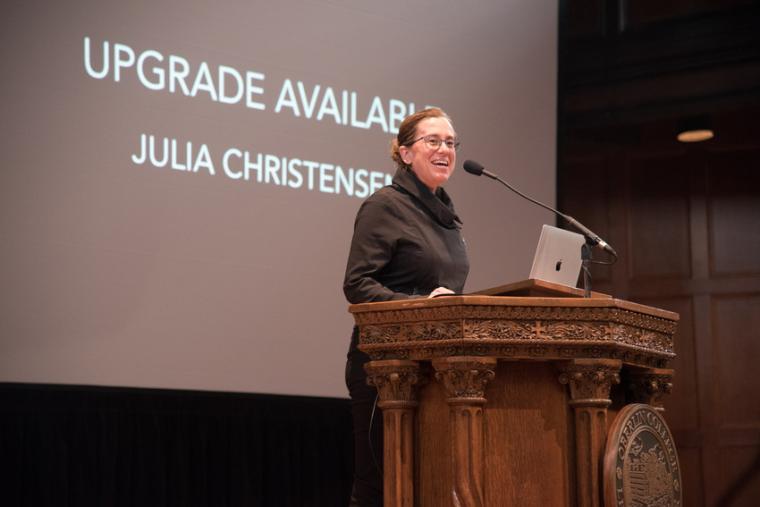Art En Route to Proxima B
December 6, 2018
Erin Ulrich ’18

Associate Professor of Integrated Media Julia Christensen delivering the President's Lecture in November
Photo credit: William Bradford
Associate Professor of Integrated Media Julia Christensen is currently working with NASA scientists at the Jet Propulsion Laboratory (JPL) in Pasadena, California. She is working on a project envisioning artwork where no artwork has gone before: aboard an interstellar space mission en route to Proxima b, an exoplanet outside our Sun’s solar system.
Associate Professor of Integrated Media Julia Christensen, along with scientists at the JPL, are working together to envisage an artwork that is designed to travel four light years from Earth and arrive at its destination in the year 2109. Christensen, tasked with a project that won’t reach its destination until long beyond the lifetimes of everyone currently working on it, is not dissuaded, but intrigued.
Her scholarship focuses on longevity at the intersections of consumer culture, obsolescence, and technology, specifically the demands that we constantly upgrade our devices to remain relevant. By earning the 2017-2018 LACMA Art + Tech Lab Fellowship, Christensen has been able to expand on her ongoing art and research project, Upgrade Available. At the Los Angeles County Museum of Art (LACMA), she is studying the museum’s capacity to keep up with “upgrade culture,” and how LACMA's fate is shared by museums and institutions as a whole.
“How does the museum archivist function,” Christensen says, “in a landscape of endlessly shifting media forms? How do exhibitions remain relevant as artists increasingly integrate digital tools into their work, when museums have not necessarily invested in the technology to show the work? These are some of the questions my work is asking.”
Christensen’s current research coalesces with the courses she teaches at Oberlin, such as VisPro Media Archaeology.
“I learned a lot from teaching that class, and from doing a close read of a range of articles with my students,” she says. “My students broaden my perspective on the relationship between time and technology, since their experience is different than mine, which is different than the scientists at NASA.”
Christensen first began thinking about the interconnectedness of memory, identity, and technology upon visiting an “e-waste” processing center outside Chennai, a city in Eastern India, in 2012. It was then that she started exploring the ramifications of “planned obsolescence,” the notion that our devices–which in many ways have become extensions of ourselves—are designed to inevitably become outdated.
So how did her visit to a graveyard of forgotten and discarded memories lead Christensen to a room full of rocket scientists and specialists in exo-planetary science and artificial intelligence?
Christensen was introduced to scientists at the JPL by the LACMA Art + Technology Lab, which is backed by SpaceX, Google, and DreamWorks Animation. Currently, she is working with scientists at the JPL to design an artwork to travel via a proposed mission to Proxima b, an exoplanet in the Alpha Centauri system on a spacecraft designed to house the art throughout its 40-year mission.
When asked what it’s been like to work with NASA scientists, Christensen remarks, “It is incredibly inspirational. The scientists at the JPL are nothing less than visionary, and it is exciting to imagine technology, art, and our story existing in the very long term.”
The story the artwork will tell is meant to communicate what life on Earth is like to intelligent life that may one day intercept the spacecraft. Christensen says that the JPL team is asking how this spacecraft can reflect our civilization’s changing nature. The project resembles the Golden Record, a 12-inch gold-plated disk aboard Voyager 1 and 2, that contains sounds and images portraying life on Earth, including music by Mozart and Louis Armstrong.
The spacecraft’s journey to Proxima b is proposed to begin in 2069, and may not even carry a physical work of art, Christensen says. “It might be light, or video, or sound waves. We are even talking about creating a generative algorithm, so that the spacecraft produces the art while in flight.”
The launch is proposed to take place on the 100th anniversary of the Apollo mission. The JPL intends for the interstellar spacecraft to travel at one-tenth the speed of light.
You may also like…
Josh Nolan Named Vice President, General Counsel, and Secretary at Oberlin
Distinguished attorney brings extensive experience in higher education law.
Learning by Teaching: Oberlin Students Share Global Music with Young Learners
College and Conservatory students in PACE 103 prepare local children for an immersive community concert at Oberlin.
Nuiko Wadden ’02 Joins Oberlin Conservatory Faculty as Assistant Professor of Harp
The versatile musician brings extensive opera, orchestral, and contemporary music experience to her role


